Hilde Kuehne
M2SVid: End-to-End Inpainting and Refinement for Monocular-to-Stereo Video Conversion
May 22, 2025Abstract:We tackle the problem of monocular-to-stereo video conversion and propose a novel architecture for inpainting and refinement of the warped right view obtained by depth-based reprojection of the input left view. We extend the Stable Video Diffusion (SVD) model to utilize the input left video, the warped right video, and the disocclusion masks as conditioning input to generate a high-quality right camera view. In order to effectively exploit information from neighboring frames for inpainting, we modify the attention layers in SVD to compute full attention for discoccluded pixels. Our model is trained to generate the right view video in an end-to-end manner by minimizing image space losses to ensure high-quality generation. Our approach outperforms previous state-of-the-art methods, obtaining an average rank of 1.43 among the 4 compared methods in a user study, while being 6x faster than the second placed method.
Omni-R1: Do You Really Need Audio to Fine-Tune Your Audio LLM?
May 14, 2025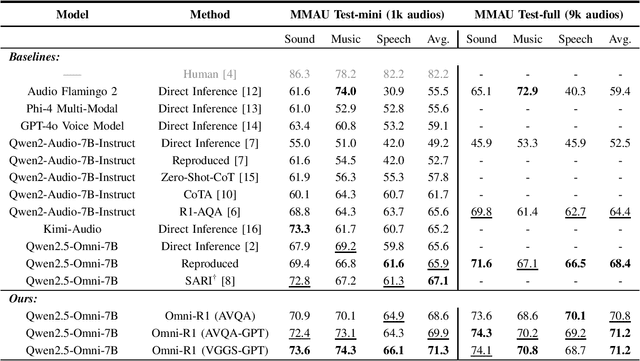
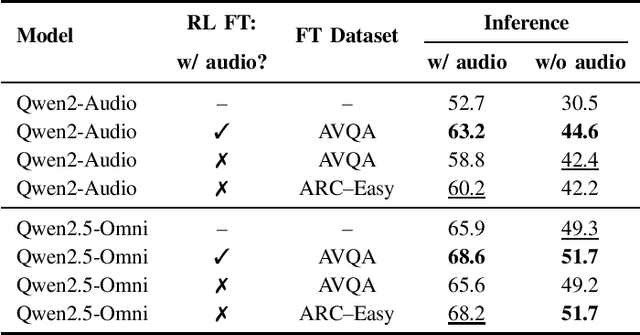
Abstract:We propose Omni-R1 which fine-tunes a recent multi-modal LLM, Qwen2.5-Omni, on an audio question answering dataset with the reinforcement learning method GRPO. This leads to new State-of-the-Art performance on the recent MMAU benchmark. Omni-R1 achieves the highest accuracies on the sounds, music, speech, and overall average categories, both on the Test-mini and Test-full splits. To understand the performance improvement, we tested models both with and without audio and found that much of the performance improvement from GRPO could be attributed to better text-based reasoning. We also made a surprising discovery that fine-tuning without audio on a text-only dataset was effective at improving the audio-based performance.
REVEAL: Relation-based Video Representation Learning for Video-Question-Answering
Apr 07, 2025Abstract:Video-Question-Answering (VideoQA) comprises the capturing of complex visual relation changes over time, remaining a challenge even for advanced Video Language Models (VLM), i.a., because of the need to represent the visual content to a reasonably sized input for those models. To address this problem, we propose RElation-based Video rEpresentAtion Learning (REVEAL), a framework designed to capture visual relation information by encoding them into structured, decomposed representations. Specifically, inspired by spatiotemporal scene graphs, we propose to encode video sequences as sets of relation triplets in the form of (\textit{subject-predicate-object}) over time via their language embeddings. To this end, we extract explicit relations from video captions and introduce a Many-to-Many Noise Contrastive Estimation (MM-NCE) together with a Q-Former architecture to align an unordered set of video-derived queries with corresponding text-based relation descriptions. At inference, the resulting Q-former produces an efficient token representation that can serve as input to a VLM for VideoQA. We evaluate the proposed framework on five challenging benchmarks: NeXT-QA, Intent-QA, STAR, VLEP, and TVQA. It shows that the resulting query-based video representation is able to outperform global alignment-based CLS or patch token representations and achieves competitive results against state-of-the-art models, particularly on tasks requiring temporal reasoning and relation comprehension. The code and models will be publicly released.
VideoGEM: Training-free Action Grounding in Videos
Mar 26, 2025Abstract:Vision-language foundation models have shown impressive capabilities across various zero-shot tasks, including training-free localization and grounding, primarily focusing on localizing objects in images. However, leveraging those capabilities to localize actions and events in videos is challenging, as actions have less physical outline and are usually described by higher-level concepts. In this work, we propose VideoGEM, the first training-free spatial action grounding method based on pretrained image- and video-language backbones. Namely, we adapt the self-self attention formulation of GEM to spatial activity grounding. We observe that high-level semantic concepts, such as actions, usually emerge in the higher layers of the image- and video-language models. We, therefore, propose a layer weighting in the self-attention path to prioritize higher layers. Additionally, we introduce a dynamic weighting method to automatically tune layer weights to capture each layer`s relevance to a specific prompt. Finally, we introduce a prompt decomposition, processing action, verb, and object prompts separately, resulting in a better spatial localization of actions. We evaluate the proposed approach on three image- and video-language backbones, CLIP, OpenCLIP, and ViCLIP, and on four video grounding datasets, V-HICO, DALY, YouCook-Interactions, and GroundingYouTube, showing that the proposed training-free approach is able to outperform current trained state-of-the-art approaches for spatial video grounding.
Unbiasing through Textual Descriptions: Mitigating Representation Bias in Video Benchmarks
Mar 24, 2025Abstract:We propose a new "Unbiased through Textual Description (UTD)" video benchmark based on unbiased subsets of existing video classification and retrieval datasets to enable a more robust assessment of video understanding capabilities. Namely, we tackle the problem that current video benchmarks may suffer from different representation biases, e.g., object bias or single-frame bias, where mere recognition of objects or utilization of only a single frame is sufficient for correct prediction. We leverage VLMs and LLMs to analyze and debias benchmarks from such representation biases. Specifically, we generate frame-wise textual descriptions of videos, filter them for specific information (e.g. only objects) and leverage them to examine representation biases across three dimensions: 1) concept bias - determining if a specific concept (e.g., objects) alone suffice for prediction; 2) temporal bias - assessing if temporal information contributes to prediction; and 3) common sense vs. dataset bias - evaluating whether zero-shot reasoning or dataset correlations contribute to prediction. We conduct a systematic analysis of 12 popular video classification and retrieval datasets and create new object-debiased test splits for these datasets. Moreover, we benchmark 30 state-of-the-art video models on original and debiased splits and analyze biases in the models. To facilitate the future development of more robust video understanding benchmarks and models, we release: "UTD-descriptions", a dataset with our rich structured descriptions for each dataset, and "UTD-splits", a dataset of object-debiased test splits.
mWhisper-Flamingo for Multilingual Audio-Visual Noise-Robust Speech Recognition
Feb 03, 2025Abstract:Audio-Visual Speech Recognition (AVSR) combines lip-based video with audio and can improve performance in noise, but most methods are trained only on English data. One limitation is the lack of large-scale multilingual video data, which makes it hard hard to train models from scratch. In this work, we propose mWhisper-Flamingo for multilingual AVSR which combines the strengths of a pre-trained audio model (Whisper) and video model (AV-HuBERT). To enable better multi-modal integration and improve the noisy multilingual performance, we introduce decoder modality dropout where the model is trained both on paired audio-visual inputs and separate audio/visual inputs. mWhisper-Flamingo achieves state-of-the-art WER on MuAViC, an AVSR dataset of 9 languages. Audio-visual mWhisper-Flamingo consistently outperforms audio-only Whisper on all languages in noisy conditions.
TimeLogic: A Temporal Logic Benchmark for Video QA
Jan 13, 2025Abstract:Temporal logical understanding, a core facet of human cognition, plays a pivotal role in capturing complex sequential events and their temporal relationships within videos. This capability is particularly crucial in tasks like Video Question Answering (VideoQA), where the goal is to process visual data over time together with textual data to provide coherent answers. However, current VideoQA benchmarks devote little focus to evaluating this critical skill due to the challenge of annotating temporal logic. Despite the advancement of vision-language models, assessing their temporal logical reasoning powers remains a challenge, primarily due to the lack QA pairs that demand formal, complex temporal reasoning. To bridge this gap, we introduce the TimeLogic QA (TLQA) framework to automatically generate the QA pairs, specifically designed to evaluate the temporal logical understanding. To this end, TLQA leverages temporal annotations from existing video datasets together with temporal operators derived from logic theory to construct questions that test understanding of event sequences and their temporal relationships. TLQA framework is generic and scalable, capable of leveraging both, existing video action datasets with temporal action segmentation annotations, or video datasets with temporal scene graph annotations, to automatically generate temporal logical questions. We leverage 4 datasets, STAR, Breakfast, AGQA, and CrossTask, and generate two VideoQA dataset variants - small (TLQA-S) and large (TLQA-L) - containing 2k and 10k QA pairs for each category, resulting in 32k and 160k total pairs per dataset. We undertake a comprehensive evaluation of leading-edge VideoQA models, employing the TLQA to benchmark their temporal logical understanding capabilities. We assess the VideoQA model's temporal reasoning performance on 16 categories of temporal logic with varying temporal complexity.
State-Space Large Audio Language Models
Nov 24, 2024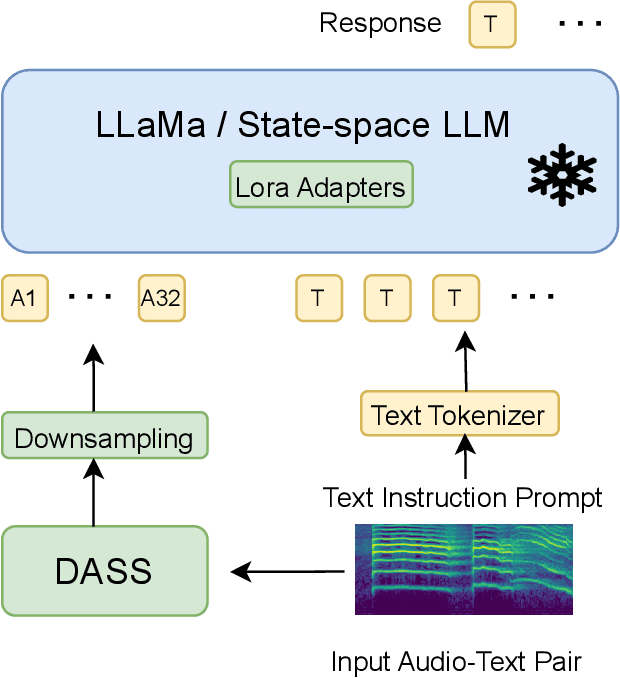
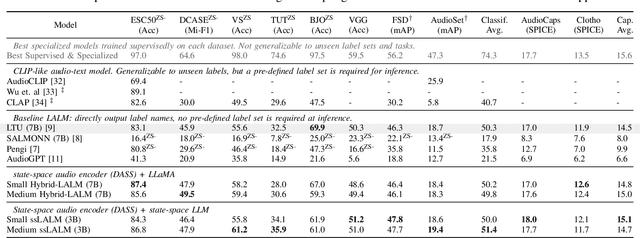
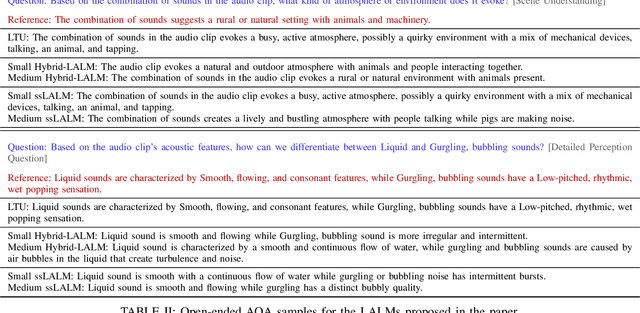
Abstract:Large Audio Language Models (LALM) combine the audio perception models and the Large Language Models (LLM) and show a remarkable ability to reason about the input audio, infer the meaning, and understand the intent. However, these systems rely on Transformers which scale quadratically with the input sequence lengths which poses computational challenges in deploying these systems in memory and time-constrained scenarios. Recently, the state-space models (SSMs) have emerged as an alternative to transformer networks. While there have been successful attempts to replace transformer-based audio perception models with state-space ones, state-space-based LALMs remain unexplored. First, we begin by replacing the transformer-based audio perception module and then replace the transformer-based LLM and propose the first state-space-based LALM. Experimental results demonstrate that space-based LALM despite having a significantly lower number of parameters performs competitively with transformer-based LALMs on close-ended tasks on a variety of datasets.
Teaching VLMs to Localize Specific Objects from In-context Examples
Nov 20, 2024



Abstract:Vision-Language Models (VLMs) have shown remarkable capabilities across diverse visual tasks, including image recognition, video understanding, and Visual Question Answering (VQA) when explicitly trained for these tasks. Despite these advances, we find that current VLMs lack a fundamental cognitive ability: learning to localize objects in a scene by taking into account the context. In this work, we focus on the task of few-shot personalized localization, where a model is given a small set of annotated images (in-context examples) -- each with a category label and bounding box -- and is tasked with localizing the same object type in a query image. To provoke personalized localization abilities in models, we present a data-centric solution that fine-tunes them using carefully curated data from video object tracking datasets. By leveraging sequences of frames tracking the same object across multiple shots, we simulate instruction-tuning dialogues that promote context awareness. To reinforce this, we introduce a novel regularization technique that replaces object labels with pseudo-names, ensuring the model relies on visual context rather than prior knowledge. Our method significantly enhances few-shot localization performance without sacrificing generalization, as demonstrated on several benchmarks tailored to personalized localization. This work is the first to explore and benchmark personalized few-shot localization for VLMs, laying a foundation for future research in context-driven vision-language applications. The code for our project is available at https://github.com/SivanDoveh/IPLoc
Convolutional Differentiable Logic Gate Networks
Nov 07, 2024



Abstract:With the increasing inference cost of machine learning models, there is a growing interest in models with fast and efficient inference. Recently, an approach for learning logic gate networks directly via a differentiable relaxation was proposed. Logic gate networks are faster than conventional neural network approaches because their inference only requires logic gate operators such as NAND, OR, and XOR, which are the underlying building blocks of current hardware and can be efficiently executed. We build on this idea, extending it by deep logic gate tree convolutions, logical OR pooling, and residual initializations. This allows scaling logic gate networks up by over one order of magnitude and utilizing the paradigm of convolution. On CIFAR-10, we achieve an accuracy of 86.29% using only 61 million logic gates, which improves over the SOTA while being 29x smaller.
 Add to Chrome
Add to Chrome Add to Firefox
Add to Firefox Add to Edge
Add to Edge